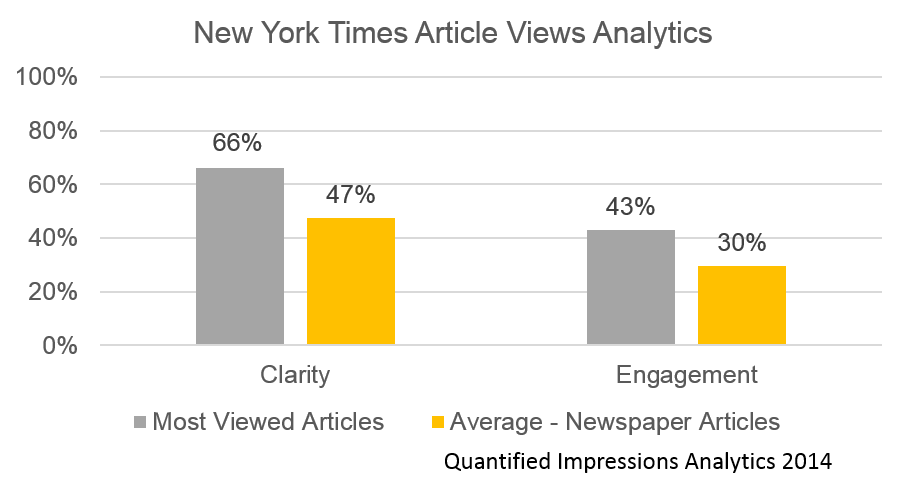What Makes Us Share? Using language analytics to predict the virality of New York Times Articles

It’s no secret that we love to share links to stories, videos, or pictures that capture our attention with others online. Studies show that 59% of people report frequently forwarding information found on the internet, and it is estimated that someone tweets a link to a New York Times story once every 4 seconds.
Our impulse to share is especially relevant today because we get our news from evolving media sources. Cultivating readership is crucial to staying prominent. In its leaked report on innovation last week, The New York Times revealed plans to form teams specifically focused on audience development, analytics and strategy, and a digital first strategy.
So we wondered, can you use analytics to predict potential audience development? Why does some content make you immediately want to hit share, while other content goes no further than your screen? Can we identify the language components that make content go viral and on what platform readers will share?
Leveraging our Quantified Communications platform, we set out to analyze what language components best predict whether we will share content. Given the editorial quality and available content, we chose articles from the New York Times as our data source. Using our natural language processing and linguistic mapping technology, we analyzed the following from the past week:
- The 20 most-viewed New York Times articles
- The 20 most-emailed New York Times articles
- The 20 most-tweeted New York Times articles
- Our database average of Newspaper Articles
- Our first question was what are the language characteristics that separate the most-viewed articles from average newspaper articles?We discovered that the most statistically significant measures are message clarity and engagement. The most-viewed articles contained 19% clearer writing and 13% more engaging writing than the average newspaper article. Message clarity is especially important in a written context. Without any nonverbal communication tools at their disposal, authors must work to clarify their message through words alone. With the average audience attention span decreasing from 12 to 5 minutes over the past ten years, it makes sense that engagement would be important as well. Authors must fully engage their readers if they want their entire article to be read.
To take this a step further, what if you want your article to be shared after it is viewed?
- What language characteristics separate the most-shared (emailed and tweeted) from the most-viewed articles?Through our communications data analyses, we found the differences in thought leadership, persuasive language, and statistics to be significant. When compared to the most-viewed articles, the most-shared articles contained:
- 24% more thought leadership
- 11% more persuasive language
- 28% more statistics
Why does thought leadership lead to more shares? When sharing a news article, the desire is to create a discussion and social experience from the shared information. In order for this kind of interaction to be achieved, the information being shared needs to be thought provoking enough to motivate discussion and socializing.
What about persuasive language and statistics? Persuasive characteristics in stories that were among the most tweeted included higher levels of insightful language. Providing reasoning for why decisions were made (insight) demonstrates to readers a sense of credibility and is therefore more persuasive. Research has shown that if the content a user shares turns out to be credible, the sharer in turn will appear to be credible and be seen as an opinion leader within the community. This may also help to explain why the inclusion of statistics was higher in the most-tweeted articles.
- Is there a correlation between communication effectiveness and the way in which articles are shared – is there a difference between articles shared via email and articles shared on Twitter?Our analysis revealed that the key differentiating factor in the way articles are shared is message clarity: The most-emailed articles were 7% clearer than the most-tweeted articles. This finding suggests that emailed articles are held to a higher standard in terms of message clarity. Interestingly, Time Magazine reported that the CEO of Chartbeat, a company that measures website traffic, “found effectively no correlation between social shares and people actually reading.” Articles are more likely to be read in their entirety when sent via email as opposed to the Twitter platform.Knowing why people email or share is critical to creating audience development. There are different reasons why people read the news, go online, tweet, or share articles; some want connection, some want information, and some want status. Our research shows that by using clear, thought-provoking language that provides insight, news outlets can boost their articles so that they will not only be read but also shared with a much wider, global audience.
While we appreciate that the data may reveal significant differences in the language components that inspire people to share, we also know that there is no algorithm that can replace creativity and editorial quality.

